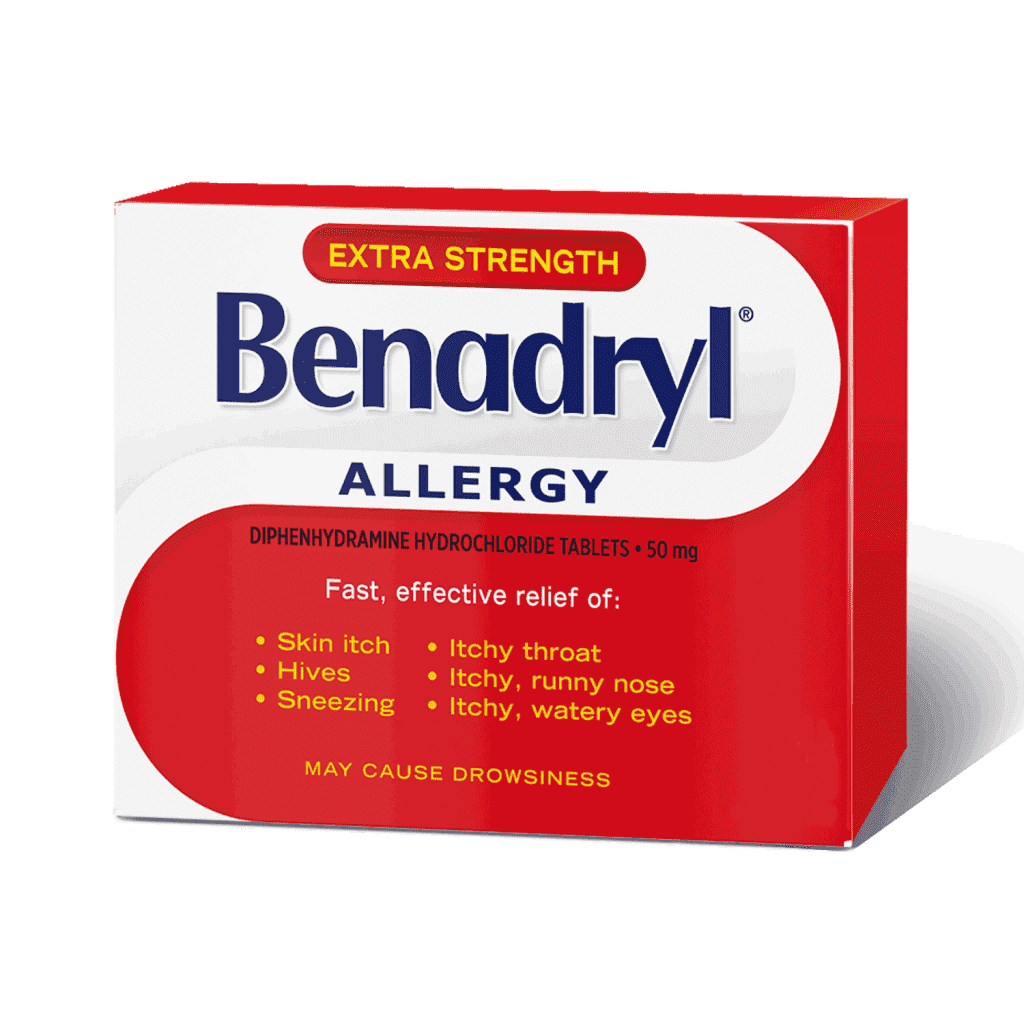Benadryl Allergy Relief: Dosage, Side Effects, and More
Allergies can disrupt your daily life, causing discomfort and inconvenience. Fortunately, there are practical solutions like Benadryl Allergy Relief. In this comprehensive guide, we’ll explore what Benadryl is, how it works, and its benefits in managing allergy symptoms.
What is Benadryl Allergy?
Benadryl Allergy Relief, a trusted household name, is a go-to choice for many seeking relief from allergies. Its active ingredient, Diphenhydramine, is renowned for its efficacy in combating various allergy symptoms. What makes Benadryl even more accessible is that it’s available over-the-counter (OTC) in most drugstores and supermarkets.
How Does Benadryl Work?
Understanding how Benadryl works can help you appreciate its effectiveness. This medication belongs to the antihistamine class, which means it counteracts the effects of histamine – a chemical released by your body during an allergic reaction. Histamine triggers symptoms like sneezing, itching, and runny nose. Benadryl’s mechanism of action blocks histamine receptors, offering quick relief from these discomforts.
Common Allergy Symptoms Addressed by Benadryl
Benadryl Allergy Relief is celebrated for its versatility in tackling various allergy symptoms. Let’s explore some of the most common discomforts it can help alleviate:
Sneezing:
Sneezing fits caused by allergens in the air can be both annoying and embarrassing. Benadryl’s antihistamine action can put an end to those sudden sneezing bouts.
Runny Nose:
A runny nose is a hallmark allergy symptom, often accompanied by nasal congestion. Benadryl’s ability to dry up excessive nasal secretions can bring you much-needed relief.
Itching and Skin Rash:
Whether it’s due to insect bites, poison ivy, or hives, itching can be maddening. Benadryl’s antihistamine effect can help ease the itch and reduce redness.
Dosage and Administration
Proper dosage and administration are essential for getting the best results from Benadryl while minimizing the risk of side effects. Here are some key guidelines:
For Adults:
The standard dosage for adults is 25 to 50 milligrams (mg) every 4 to 6 hours as needed.
Do not exceed 300 mg in a 24-hour period unless directed by a healthcare professional.
Always follow the instructions on the product label.
For Children:
Children’s Benadryl is available in various forms (liquids, chewable tablets, etc.), and dosages vary based on age and weight.
It’s crucial to consult a pediatrician or follow the dosing instructions on the product label for children.
Special Considerations:
If you are pregnant, nursing, or have underlying medical conditions, consult your healthcare provider before using Benadryl.
Avoid alcohol while taking Benadryl, as it can increase drowsiness.
Side Effects and Precautions
While Benadryl is a widely trusted allergy medication, it’s essential to be aware of potential side effects and take necessary precautions:
If you experience severe side effects such as difficulty breathing, chest pain, or swelling of the face and throat, seek immediate medical attention. These are signs of a severe allergic reaction.

Benadryl allergy
Alternative Allergy Relief Options
While Benadryl is a reliable choice for allergy relief, some individuals prefer non-medication approaches or want to complement their treatment with natural remedies. Here are some alternative options to consider:
Allergen Avoidance:
Identify and avoid allergens that trigger your symptoms. This may include dust mites, pollen, pet dander, or certain foods.
Nasal Irrigation:
Use saline nasal sprays or a Neti pot to rinse allergens from your nasal passages.
HEPA Air Purifiers:
Invest in high-efficiency particulate air (HEPA) filters to reduce allergen levels indoors.
User Reviews and Experiences
Real-life experiences can provide valuable insights into the effectiveness of Benadryl Allergy Relief. Here are some user testimonials:
Sarah H., 34:
“I’ve struggled with seasonal allergies for years, and Benadryl has been a game-changer. It’s my go-to when pollen levels soar. It does make me a bit drowsy, but the relief it provides is worth it.”
Benadryl Allergy Relief FAQs
Q: What is Benadryl Allergy Relief?
A: Benadryl Allergy Relief is an over-the-counter (OTC) medication that contains Diphenhydramine, an antihistamine. It’s commonly used to relieve allergy symptoms like sneezing, runny nose, itching, and hives.
Q: How does Benadryl work?
A: Benadryl works by blocking the effects of histamine, a chemical that triggers allergy symptoms. By inhibiting histamine, Benadryl provides relief from common allergic reactions.
Q: Can I take Benadryl for hay fever or seasonal allergies?
A: Yes, Benadryl is effective in alleviating symptoms of hay fever and seasonal allergies, such as sneezing, itchy eyes, and runny nose.
Q: Is Benadryl safe for children?
A: Benadryl offers pediatric formulations suitable for children, but it’s essential to follow the dosing instructions provided on the product label or consult a pediatrician for proper usage.
Q: Does Benadryl cause drowsiness?
A: Yes, one common side effect of Benadryl is drowsiness. It’s advisable to avoid activities requiring alertness, such as driving while taking Benadryl if you experience drowsiness.
Q: How quickly does Benadryl work?
A: Benadryl typically starts to provide relief within 30 minutes to an hour after ingestion, but individual response times may vary.
Q: Can I take Benadryl with other medications?
A: It’s important to consult a healthcare provider or pharmacist before combining Benadryl with other medications to avoid potential drug interactions.
Q: Are there non-drowsy alternatives to Benadryl?
A: Yes, there are non-drowsy antihistamine options available, which may be suitable for individuals who want allergy relief without the sedative effects.
Q: Can I use Benadryl for insect bites or stings?
A: Yes, Benadryl can help relieve itching and discomfort caused by insect bites or stings. Apply a topical Benadryl cream or take an oral formulation as directed.
Q: Is Benadryl suitable for long-term use?
A: Prolonged use of Benadryl should be done under medical supervision. It’s advisable to consult a healthcare provider for extended or recurrent allergy symptoms.
Conclusion
In conclusion, Benadryl Allergy Relief, with its active ingredient Diphenhydramine, is a trusted solution for managing a wide range of allergy symptoms. It effectively combats sneezing, runny nose, itching, hives, and more by blocking the action of histamine.




